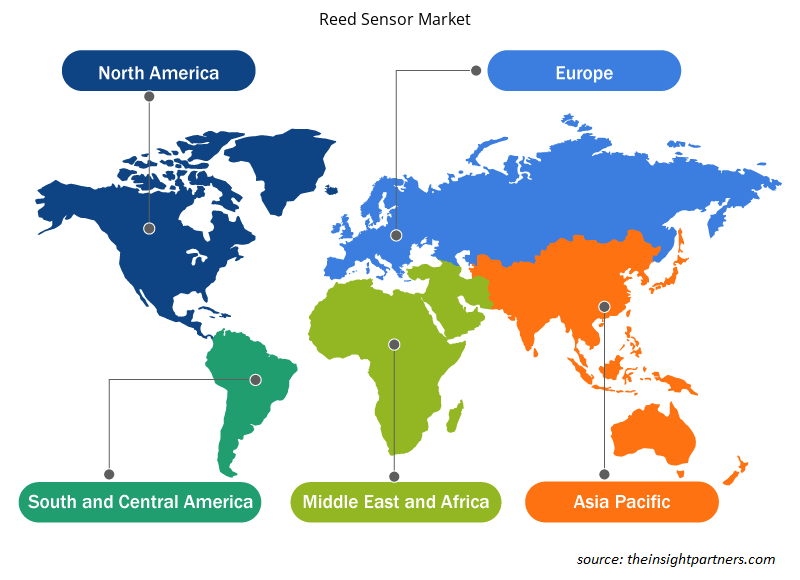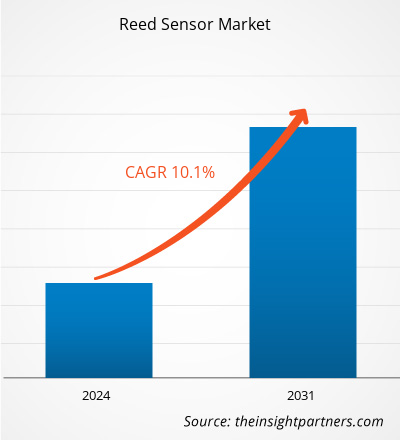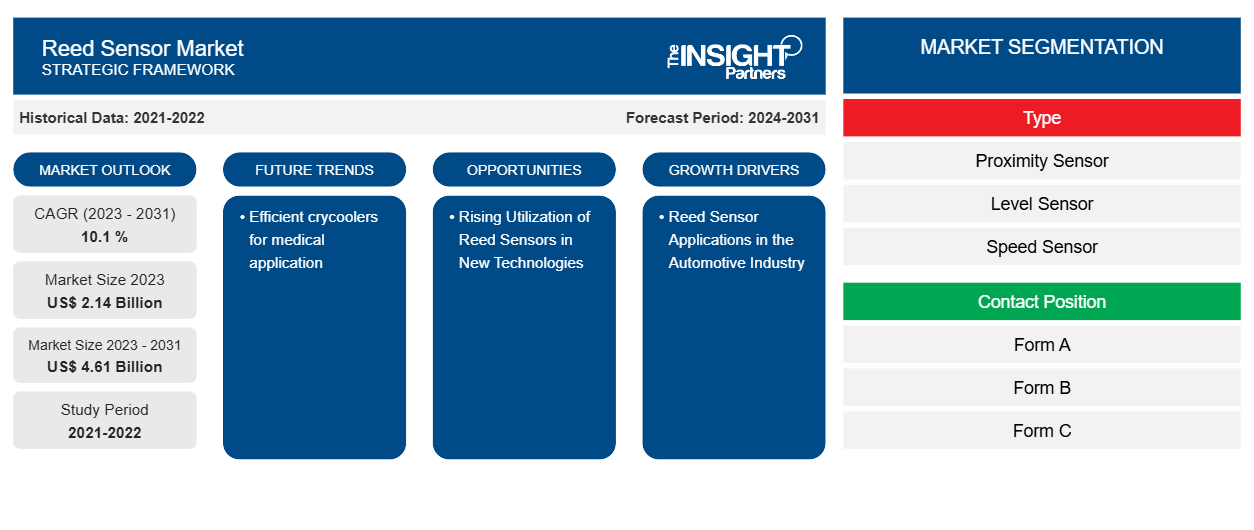预计到 2031 年,干簧传感器市场规模将从 2023 年的 21.4 亿美元增至 46.1 亿美元。预计 2023-2031 年市场复合年增长率将达到 10.1%。由于各种变量推动了各行各业的技术发展,需求正在迅速增加。
干簧传感器市场分析
簧片传感器因其可靠而简单的检测和驱动能力、低成本和零功耗操作要求,广泛应用于汽车行业,尤其是汽车内饰。因此,汽车行业的扩张预计将在未来推动簧片传感器的使用。然而,机器人和自动化应用对簧片传感器的需求预计将随着时间的推移而增加。
干簧传感器市场概况
簧片传感器具有多种优势,包括简单可靠的传感和驱动能力、低廉的成本和最小的功耗要求以及在恶劣的工业环境中的安全性。这些因素有助于市场扩张。随着新应用和技术的发展,市场获得了发展动力。传感器用于各种应用,包括电信、汽车和运输、消费电子和家电、安全和安保、医疗保健、建筑、机器人和自动化。
定制此报告以满足您的需求
您可以免费定制任何报告,包括本报告的部分内容、国家级分析、Excel 数据包,以及为初创企业和大学提供优惠和折扣
-
获取此报告的关键市场趋势。这个免费样品将包括数据分析,从市场趋势到估计和预测。
干簧传感器市场驱动因素和机遇
干簧传感器在汽车行业的应用受到市场青睐
汽车包含许多传感器,可确保其众多部件正常运行。簧片传感器广泛用于汽车内饰,以确保安全性和可靠性。簧片传感器因其低功耗和长寿命而非常适合汽车应用。簧片传感器用于各种汽车应用,包括遮阳板、早期制动传感、废气排放传感、电动车窗、油箱盖位置传感、防抱死制动、冷却液流量传感、故障灯检测、低液位监控、电池寿命指示器、安全带锁定传感、安全气囊展开预防、车门传感器、巡航控制和动力转向。汽车行业的增长推动了簧片传感器市场的发展。
干簧传感器在新技术中的应用日益广泛
新兴技术中簧片传感器的使用增加将创造新的市场可能性并加速市场的增长速度。由于传感器和开关技术的进步,高度小型化和极其可靠的簧片开关的趋势正在成为各种终端用户行业中簧片传感器的驱动力。此外,政府鼓励发展中国家和新兴市场生产消费电子产品的优惠举措将成为市场驱动力,提高行业的增长率。
干簧传感器市场报告细分分析
有助于得出干簧传感器市场分析的关键部分是类型、接触位置和应用。
- 根据类型,簧片传感器市场分为接近传感器、液位传感器、速度传感器和流量传感器。
- 根据接触位置,簧片传感器市场分为 A 型、B 型、C 型、D 型和其他型。
- 根据应用,市场分为汽车和运输、安全和安全、医疗、消费电子、电信等。
干簧传感器市场份额按地区分析
干簧传感器市场报告的地理范围主要分为五个区域:北美、亚太、欧洲、中东和非洲以及南美/南美和中美。亚太地区分别归功于台湾和中国的成熟电子和汽车行业。上海和北京是中国汽车、通讯设备和电子产品的主要工业中心,这推动了干簧传感器市场的扩张。在韩国,智能家居设备的增长促进了干簧传感器市场的增长。
干簧传感器市场区域洞察
Insight Partners 的分析师已详尽解释了预测期内影响干簧传感器市场的区域趋势和因素。本节还讨论了北美、欧洲、亚太地区、中东和非洲以及南美和中美洲的干簧传感器市场细分和地理位置。

- 获取干簧传感器市场的区域特定数据
干簧传感器市场报告范围
| 报告属性 | 细节 |
|---|---|
| 2023 年的市场规模 | 21.4亿美元 |
| 2031 年市场规模 | 46.1亿美元 |
| 全球复合年增长率(2023 - 2031) | 10.1% |
| 史料 | 2021-2022 |
| 预测期 | 2024-2031 |
| 涵盖的领域 |
按类型
|
| 覆盖地区和国家 |
北美
|
| 市场领导者和主要公司简介 |
|
干簧传感器市场参与者密度:了解其对业务动态的影响
干簧传感器市场正在快速增长,这得益于终端用户需求的不断增长,而这些需求又源于消费者偏好的不断变化、技术进步以及对产品优势的认识不断提高等因素。随着需求的增加,企业正在扩大其产品范围,进行创新以满足消费者的需求,并利用新兴趋势,从而进一步推动市场增长。
市场参与者密度是指在特定市场或行业内运营的企业或公司的分布情况。它表明在给定市场空间中,相对于其规模或总市场价值,有多少竞争对手(市场参与者)存在。
在干簧传感器市场运营的主要公司有:
- HSI 传感
- 科拓科技
- Littelfuse公司
- PIC有限公司
- 皮克林电子有限公司
- 远程医疗计划
免责声明:上面列出的公司没有按照任何特定顺序排列。

- 获取干簧传感器市场主要参与者的概述
干簧传感器市场新闻和最新发展
干簧传感器市场通过收集一手和二手研究后的定性和定量数据进行评估,其中包括重要的公司出版物、协会数据和数据库。以下是市场发展情况的列表:
- 2021年3月,ABLIC Inc.推出了“S-5701 B系列”表面贴装TMR(隧道磁阻)传感器IC,这是一款具有极低电流消耗、高磁灵敏度、长寿命且工作电流消耗低于160nA的磁传感器。
(来源:ABLIC Inc.,公司网站,2021 年)
- 2023 年 8 月,Littelfuse, Inc. 推出了其最新产品 59155 和 59156,这是世界上最小的超小型法兰安装簧片传感器。这些传感器的架构允许紧凑的尺寸、非接触式激活和定制,使其适用于各行各业的各种紧密间距应用。
(来源:Littelfuse, Inc.,公司网站,2022 年)
干簧传感器市场报告覆盖范围和交付成果
“干簧传感器市场规模和预测(2021-2031)”报告对以下领域进行了详细的市场分析:
- 范围内所有主要细分市场的全球、区域和国家层面的市场规模和预测
- 市场动态,如驱动因素、限制因素和关键机遇
- 未来主要趋势
- 详细的 PEST/波特五力分析和 SWOT 分析
- 全球和区域市场分析涵盖关键市场趋势、主要参与者、法规和最新市场发展
- 行业格局和竞争分析,涵盖市场集中度、热点图分析、知名参与者和最新发展
- 详细的公司简介
- 历史分析(2 年)、基准年、预测(7 年)及复合年增长率
- PEST和SWOT分析
- 市场规模、价值/数量 - 全球、区域、国家
- 行业和竞争格局
- Excel 数据集
近期报告
相关报告
客户评价
购买理由
- 明智的决策
- 了解市场动态
- 竞争分析
- 客户洞察
- 市场预测
- 风险规避
- 战略规划
- 投资论证
- 识别新兴市场
- 优化营销策略
- 提升运营效率
- 顺应监管趋势























 获取免费样品 - 簧片传感器市场
获取免费样品 - 簧片传感器市场